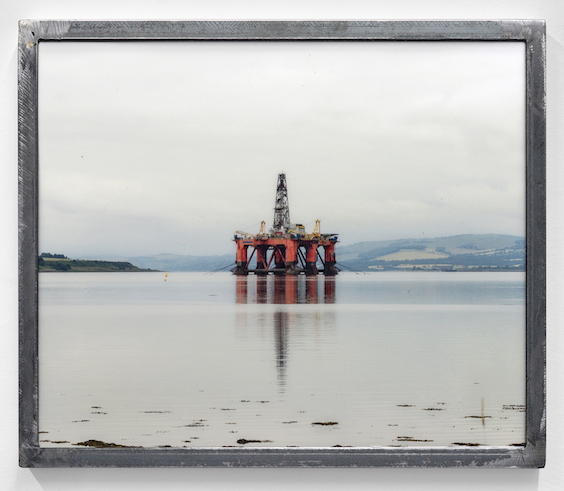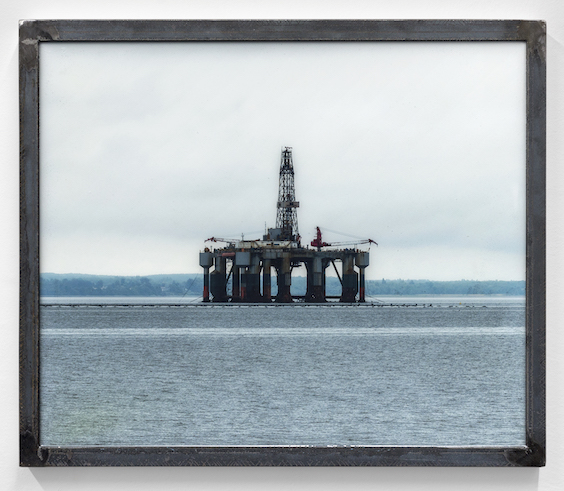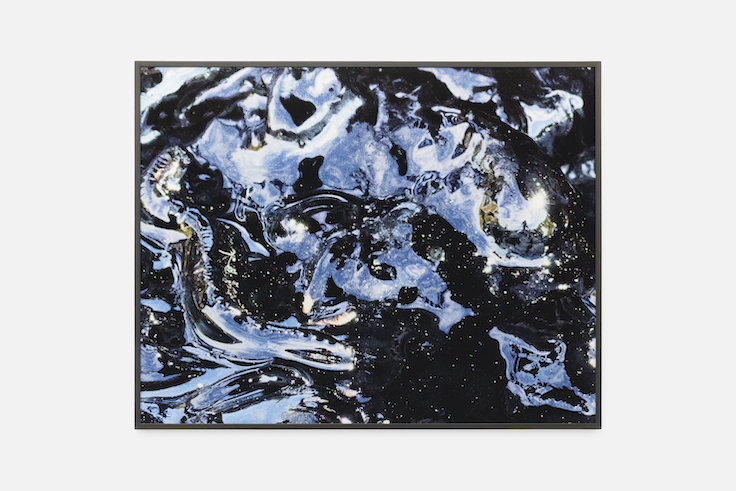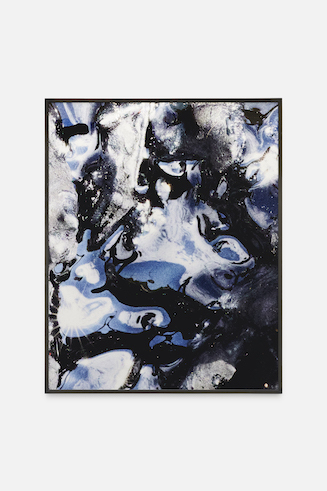Press information
Lucie Stahl
Transit Interior
Infos
Press preview
17.3.2023, 11 am
Opening
17.3.2023, 6 pm
Duration
18.3.–21.5.2023
Opening hours
Tue – Sun and bank holidays
10 am – 6 pm
Curated by
Christina Töpfer
Press downloads
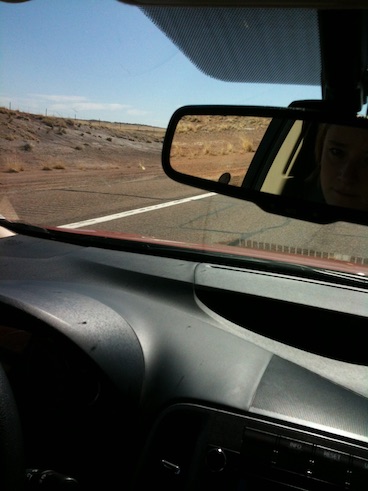
Press Information
The Better Part of Squalor
On a road trip through the California desert, Lucie Stahl discovered in an empty lot discarded soft drink cans that had been reused for target practice. Drawn to the at once shiny and matte surfaces, she added the cans to her ongoing collection of notational material for future work. The interest in discardable or recyclable but indestructible containers is certainly by now a continuity shot traversing her art. But her palette in Giants (2019), the series of photographic portraits of oil platforms hugging the shore of Scotland prior to being restationed out to sea, is a direct hit with the soda logos etiolated by the desert sun. The ghost palette is also in evidence in Stahl’s drag-king self-portraiture as milkman (Milk, Oil and Butter, 2018) pouring the liquid from container to container.
Artist Matthew Lutz-Kinoy had already initiated a reinterpretation of Filling Station, which is yet unproduced, when he invited Stahl to collaborate. Her work of course already advertised an affinity—the poster for her exhibition FUEL (Freedman Fitzpatrick Gallery, Paris, 2019) showed the artist as gas station attendant—and they added a scene to the original 1938 work, considered the first American ballet, for which Virgil Thomson composed the music and Paul Cadmus rendered the set and costume designs. In it the homoerotically cathected gas station attendant (in shredded attire rather than Cadmus’s peekaboo outfit) pours milk over a woman protester to alleviate her blinding by tear gas. In Stahl’s notational archive of collectible inspiration, there is a still from the scene in Walt Disney’s Snow White and the Seven Dwarfs, in which the princess swabs the courtyard with a soapy liquid that the artist reads, perversely or psychoanalytically, as milk.¹While Stahl’s artworks have regularly cited or summoned the Gestell or framework for extracting, storing, and distributing oil and gas, the scenes of pouring show milk. And yet the contrast or paralleling comes down to the continuous method used in each case for sucking out the energizing “fuel.”
From the offshore wells to the prayer wheels of oil consumption, set in relief against the parallel universe represented by devices for milking cows, Stahl portrays the human sensorium at the bottom line or developmental stage of sucking. While Anglo-American clinical psychology prefers to focus on “delinquency” in childhood, adolescence, and emo-adolescence, in the German-language world, Verwahrlosung, a word that literally, etymologically refers to a state of being bereft of safety, has meant for over a century a failure on the part of members of the same population to offer a minimum of conformity with social norms, all the while succumbing to squalor and dilapidation. Lucie Stahl travels through the globalized sensorium of Verwahrlosung, taking note of the symptoms for future work, reserving the better part for her art.
The condition of Verwahrlosung became the touchstone for philosophy-dictated anthropological, phenomenological, Gestalt, and/or existential modes of therapy and psychiatry to test their commitment to being with the outer limits of psychoanalysis. Already in Sein und Zeit (Being and Time, 1927)—the readings of das Unheimliche (the uncanny) and of Sorge (care) come to mind—Martin Heidegger engaged in the contact sport of stealing a precursor’s fire and claiming his share of Freud’s fame after the First World War. The therapeutic modalities in psychiatry that he inspired had, by the 1950s, all the border concepts and conditions of psychoanalysis covered, from psychosis and psychopathy to constitutional perversion. Klaus Conrad, for example, studied schizophrenia during his stint as a military psychiatrist on location on the front in 1942. Conrad’s 1958 book on the Gestaltanalyse (Gestalt analysis) of schizophrenia is based on and remains continuous with the wartime setting. He concludes that what the cases have in common is depletion of a kind of psychic reserve fuel or energy.²
In 1953, Heidegger commenced a quarrel with technology, which he saw as the summit and summary of his divergence from psychoanalysis. Among the terms he introduced at this juncture we find Verwahrlosung. Same time, same station as Conrad’s reading of schizophrenia for the postwar era, Heidegger raised the question concerning technology to address a limitless prospect of the recycling of energy, either passing directly from storage to distribution and back again, or switching back and forth between the tracks of substitution (Ersatz) and simulation.³ But there is a limit to the runaway switching of channels—a limit that fits on a runway. I’m thinking of Heidegger’s example of the plane on the taxi strip as the nonobject of technology. What the plane on standby reveals instead, Heidegger proclaims, is that it is essentially “standing-reserve” (Bestand) “inasmuch as it is ordered to ensure the possibility of transportation” (p. 298). Without fuel, however, the plane is stuck or abandoned among all the other lost container objects comprising the refuse of the refusal of safety.
All of the coordinates home on the range of philosophy’s occupation of untreatable conditions were already in place in the barracks of the Second World War. One case example, number 10 in Conrad’s study, was responsible for rationing at the military gas station. One night he went to a comrade’s quarters to go over the station ledgers and, finding the door locked, decided that everything was set up to test whether he would notice. He knocked next door and found another soldier lying on his cot. The patient noticed right away that this had all been planned to allude to his being homosexual.4 As in Freud’s rereading of the Prometheus legend, in this paranoid scene of technologization the man is directed to defend the community’s energy source against the wipeout of his own homosexual flooding.5
By this last reference at the latest we recognize that Freud went far afield from his 1905 Three Essays on the Theory of Sexuality in subsequent explorations of the borderline states of psychosis and constitutional perversion. Historians of the rise of analytic psychotherapy in Germany, which in the postwar era came to qualify, one, for insurance coverage and, two, as specialization in the medical profession, seem to drop their jaws when they note Freud’s limited interest in a therapeutic goal for psychoanalysis alongside his basic wariness of established medicine. Freud counseled getting the analysand past being preoccupied with a hoped-for cure (which counts as resistance). What emerged in analytic psychotherapy, by contrast, was the sense and direction of successful treatment and the tension span that followed between the fiat of the pure cure and the curse of untreatability. But when in 1952 Medard Boss (famous for the joint seminars he held with Heidegger in Zollikon from 1959 to 1969) redeemed his sadomasochistic patient, concluding that by the contortions of his perversion he approximated and drew out “the complete male-female existential Gestalt of love,”6 we observe sex as plain text set in a decor of existential jargon. But no matter how you present it, sex is sexuality for dummies.7
The collaborative effort of a new Filling Station, which was set aside for the near future, was on Stahl’s mind while she contemplated which on- or off-ramp to take for the show in Graz.8 The importance of the location corresponds to the input or import of a container. The layout and format of the Graz art space would have been available for showing the new choreography. But instead, since exhibiting solo, she stayed in the car she pulled up in.
At the Bonner Kunstverein in 2022, Stahl’s exhibition Seven Sisters served as a retrospective of her work to date.9 The most recent work shown in Bonn, for which she selected a harder palette, included photographs of monstrous milking machines and of oil puddles glimpsed and snapped in Albania. The latter contained phantasmagoria of prehistoric or fantasy creatures like insects preserved in amber. But there’s also another set of reflections in the layering and pooling of image resources she found in oil in water, namely, the random mirroring of the immediate setting of her taking the photographs, including her camera and herself.
It is this layer of happenstance self-reflection that is in the foreground of the Graz exhibition. We enter a car or cinema and face, in place of the rear-view and side mirrors, photographs that Stahl took a decade or so ago while on the road. In addition to the images lending shape to the car by metonymy and absence, other photos from her snapping and driving sprees paper the walls. While, as Stahl underscores, these snapshots were not at all staged, by their random documentation we recognize that the car is a gadget for producing unique images clinging to the periphery of the drive. Each image is boxed in by indexical signs of the photo-driving apparatus and its operator.
The rear-view mirror, the windshield, and the side mirror instantiate, respectively, the past, the future, and the now.10 But the now, which allows the driver to keep the car aligned with the road and free of accident, is not the present tense of ongoing tensions, the dreary presentation of time that stalls on the dead end brought to session and which the analyst seeks to dislodge by the technique of free association. Driving a car is to enter a fantasying machine, which in the future ahead of the vehicle, toward which it is moving, fulfills wishes by extrapolating from an idealized past and jump-cutting away from the present through the now of driving. Backseat driving is rampant because the driver’s seat is the fantasy point of view that everyone wants to occupy. To be a mere passenger, like on a train, means to respond to the landscape being edited by the window of transport. This was Freud’s famous analogue for how the patient was to imagine engaging in free association in session.11
The automobile came to be highly cathected on both shores of the bicoastal dialectic I once formulated as binding California and Germany, the two takes on the Teen Age, our era of emo-adolescent energy. However, the legibility of one place is vouchsafed by the cultural and historical differences that make the same place other.
Because the new world is the final frontier on Earth, it is already stream-aligned with takeoff into Outer Space. The local authors of science fiction were free to base their depictions of life on alien planets on the driving layout of Southern California, the way communities are isolated, connected, and navigated by reliance on the car alone. In the old country, the auto is a fetish of the race run in the recent past to launch a rocket beyond the limitations of fuel resources. What’s cinematic, at least for Friedrich Wilhelm Murnau, was the view from the plane. In California we still circle our wagons around the steady traversal of the unchanging landscape, which is quintessentially cinematic, while the slow momentum rolls out the Hollywood conjugation of the camera’s view, from long shot to medium shot and back again until, checking in the side mirror, we know we’re ready for our close-up.
Laurence A. Rickels
Laurence A. Rickels – http://www.larickels.com
Lucie Stahl’s work has been shown in numerous solo and group exhibitions. Her last institutional solo shows include: Seven Sisters at Kunstverein Bonn (DE, 2022), Works 2008–2018 at Kunsthalle FriArt in Fribourg (CH, 2018), Concentrations 60 – Lucie Stahl at Dallas Museum of Art, Dallas (US, 2016), and Spirit at Halle für Kunst, Lüneburg (DE, 2016). She is represented by Galerie Meyer Kainer in Vienna (AT), dépendance in Brussels (BE), Fitzpatrick Gallery in Paris (FR), and Cabinet in London (GB). She has been a professor of artistic photography at the Kunstuniversität in Linz (AT) since 2021.
1 The presentation of the studies for the Filling Station collaboration, together with documentary images both of the original designs and of the 1953 production in New York City, was part of Stahl’s Antrittsvorlesung (inaugural address) held in Linz in 2022. The still from the Disney fairy-tale animation movie was also shown on that occasion.
2 Klaus Conrad, Die beginnende Schizophrenie: Versuch einer Gestaltanalyse des Wahns (Stuttgart: G. Thieme, 1958). Conrad datemarks his case studies, but he also allowed his students at the university in Marburg to give a more complete account of Conrad’s cases in dissertations which they were completing during the Third Reich. I give a close reading of this complex of texts and intertexts in the second volume of Nazi Psychoanalysis (Minneapolis: University of Minnesota Press, 2002).
3 Martin Heidegger, “The Question Concerning Technology,” trans. William Lovitt, in Basic Writings, ed. David Farrell Krell (New York: Harper & Row, 1977), pp. 287–322. Page references are given in the text.
4 Conrad, Die beginnende Schizophrenie, pp. 51–52.
5 Sigmund Freud, “Zur Gewinnung des Feuers,” Studienausgabe, vol. IX (Frankfurt am Main: Fischer Verlag, 1974), pp. 449–54. I sometimes wonder if we owe these brilliant interventions (I’m also thinking of the analysis of Daniel Paul Schreber’s Memoirs of My Nervous Illness and the 1928 article on fetishism) to a pissing contest with philosophy.
6 Medard Boss, Sinn und Gehalt der sexuellen Perversionen: Ein daseinsanalytischer Beitrag zur Psychopathologie des Phänomens der Liebe (Munich: Kindler Verlag, 1970), p. 138.
7 Decades ago, at an exhibition opening in West Hollywood, when we were all wondering why spotlights nearby were scraping the sky as though for a film premiere, Mike Kelley flexed his Freudian irony and offered a reason for the scene of celebration: “They must have invented a new kind of blow job.”
8 I am grateful to Lucie Stahl for sending me in an email (on January 6, 2023) her extensive notes for the Graz show.
9 In her Antrittsvorlesung, the artist strolls through the Bonn exhibition to present the collected work in progress according to her guiding themes and interests.
10 The times Stahl sees the car mark conform, then, to the time zones that daydream fantasy (according to Freud) traverses, edits, and flees. See the extensive rereading of Freud’s “The Poet and Daydreaming” in tandem with J. R. R. Tolkien’s “On Fairy Stories” in the first volume of my Critique of Fantasy (Santa Barbara: Punctum Books, 2020).
11 Freud, “Zur Einleitung der Behandlung,” Studienausgabe, supplementary volume (Frankfurt am Main: Fischer Verlag, 1974), pp. 183–203, esp. pp. 194–95.
Images
Publication is permitted exclusively in the context of announcements and reviews related to the exhibition and publication. Please avoid any cropping of the images. Credits to be downloaded from the corresponding link.


